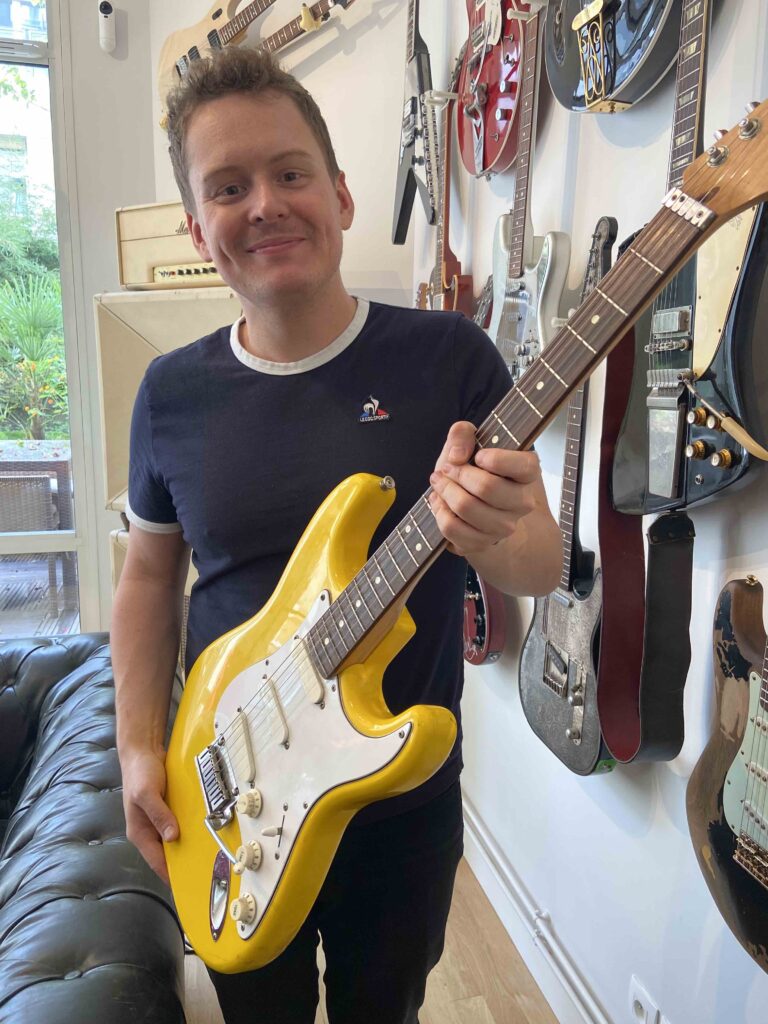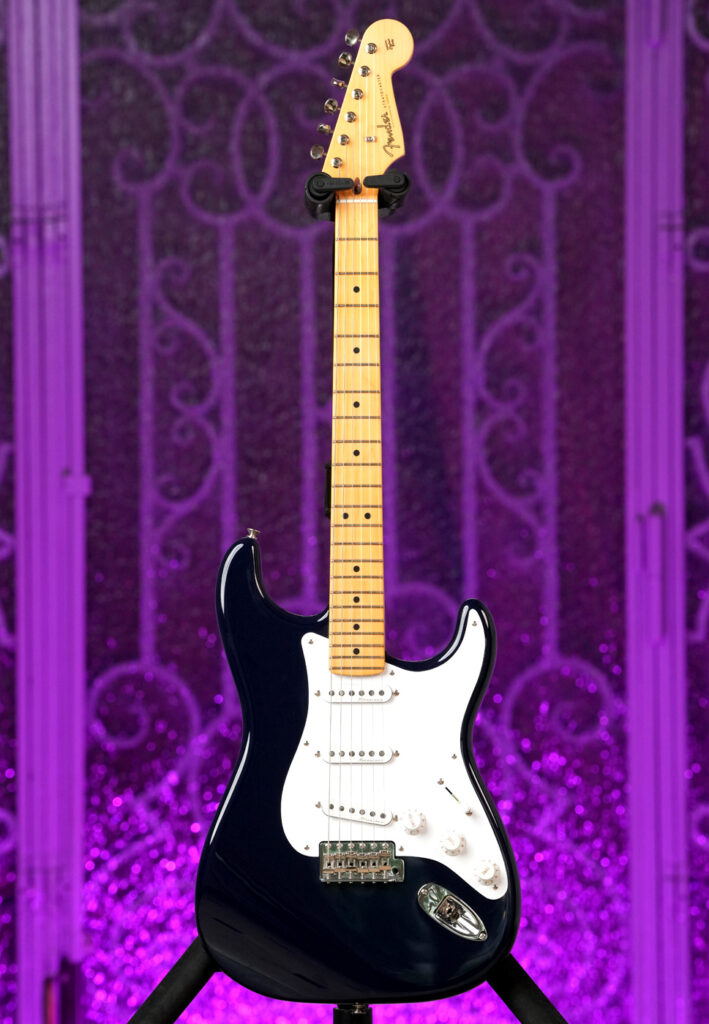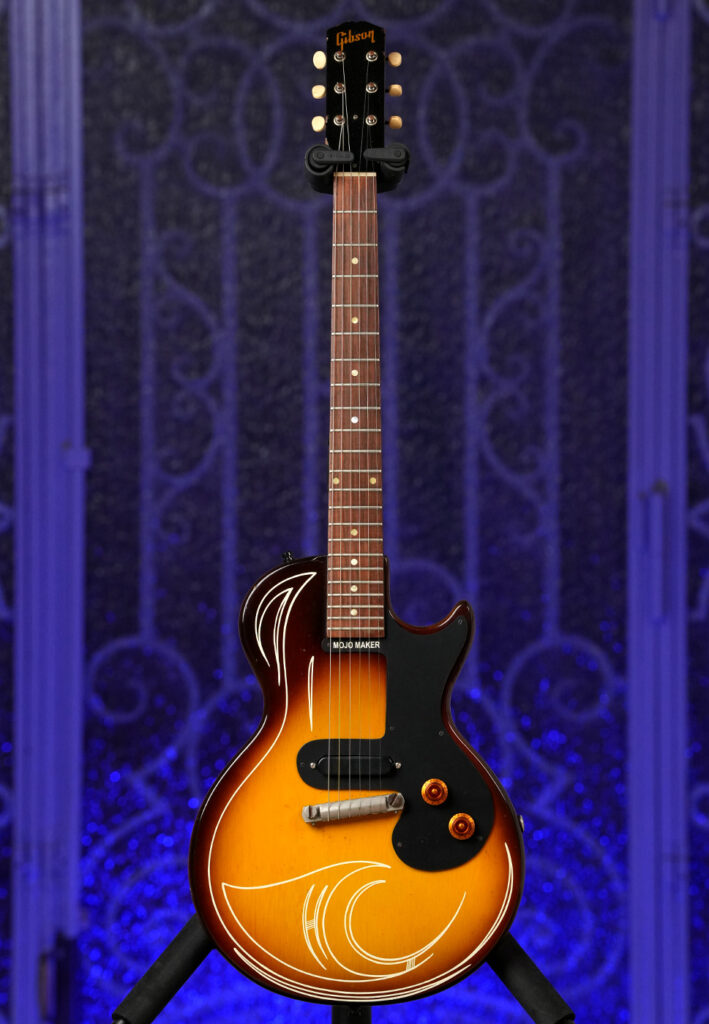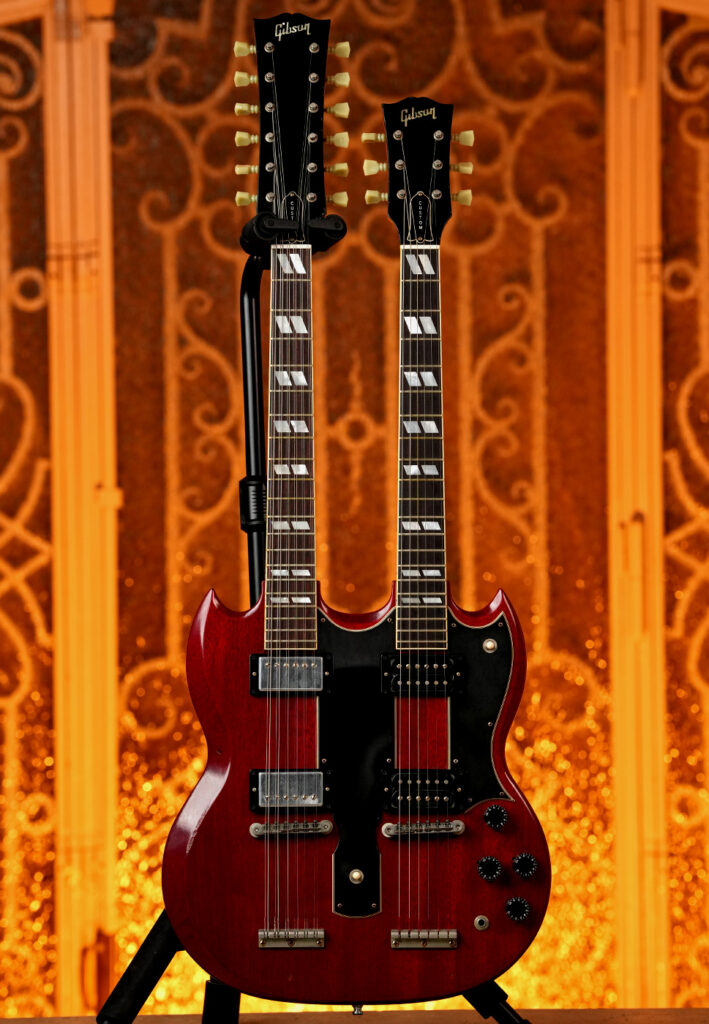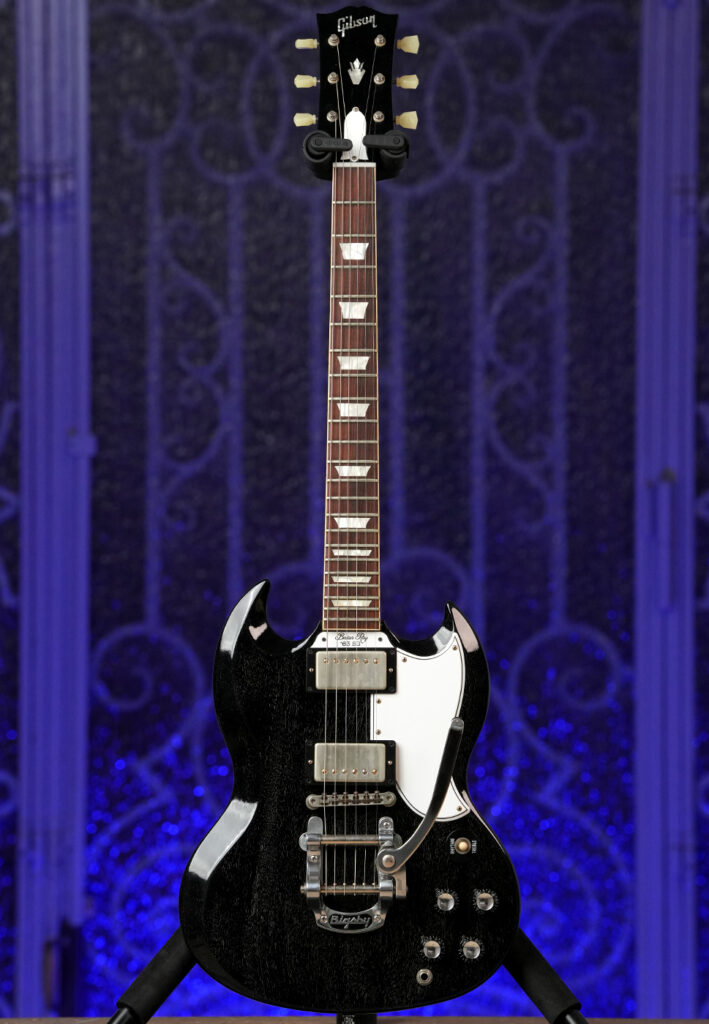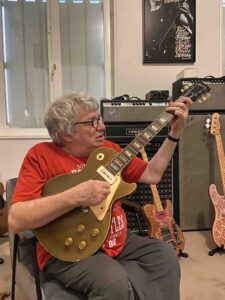The Man with the Golden Guitars
Article published on February 22, 2024, on Gonzo Music
Read the original article: https://gonzomusic.fr/lhomme-aux-guitares-dor.html
He is a very young man of 29 who looks no older than 17, but don’t be fooled by his youthful appearance. In just under seven years since launching Matt’s Guitar Shop, Matt Lucas has established himself as THE French expert in star guitars that make all musicians and rock aficionados dream, with hundreds of precious collectible instruments played by legends like Jimmy Page, Joe Perry, Keith Richards, Eric Clapton, and Lenny Kravitz. Meet the man with the golden guitars.
In a small townhouse located on a quiet street in Paris’s 17th arrondissement, far removed from the guitar shops of Pigalle, some precious sonic treasures are on display. Here, you get more the feeling of being in a high-end fashion boutique, surrounded by pieces all more magnificent and valuable than the next. Or in a museum, with historic instruments held by some of the greatest guitar heroes, some worth hundreds of thousands of euros. This doesn’t stop Matt from regularly lending the rarest jewels of his personal collection to young artists for stage or studio use, following the principle of passing on knowledge that the young man has made his guiding creed. Indeed, guitarists realize that their most precious instrument will outlive them and will eventually be played by other musicians, some of whom haven’t even been born yet. These star guitars are themselves stars in their own right — proof being Matt’s Guitar Shop…
“So Matt, how old are you?”
29 years old.
How does someone become THE specialist of historic guitars sometimes ten times older than themselves at only 29?
For me, the path to a passion for guitar and music began in early 2009. I come from a family that isn’t particularly music-loving, although my mother listened a lot to Johnny Hallyday. My father was more into Michel Sardou.
Ah yes, that’s not exactly rock and roll!
Not really, indeed. But my mother still had some old vinyl records in her attic, even if I didn’t pay much attention to them. One day, I was playing video games, I was fifteen years old, and my best friend, who is of German origin, has a strong rock and roll culture in his family. He told me: “My dad only listens to this album right now, it’s the latest AC/DC album.” Even though I wasn’t really into rock, I knew about them, but to me it was just a guy yelling into a microphone. Then I heard “Rock And Roll Train,” which opens their album *Black Ice*, with an Angus Young riff and a snare drum hit from Phil Rudd. When I describe that moment and what it did to me, it was that snare drum hit that triggered everything, like someone pressed a button in my brain.
Shock to the system!
Shock to the system. Behind that, the whole band is playing. Brian Johnson’s voice, really, totally mesmerized me because I had never heard anything like it. And mostly, unconsciously, I was discovering the groove of AC/DC’s rock and roll. And everything it would ignite as a passion in me. I was 15 years old. And since I’m ultra-passionate about everything I do, my hobbies, my interests, I started wanting to buy a guitar. Right away. And I wanted to do like Angus Young, the duckwalk shirtless in my living room.
(laughs)
And I identified with this character who is a true guitar hero. Because, to me, the definition of a guitar hero is the guy who can make you transcend at home, whether it’s with a real guitar or even an air guitar. I started listening to AC/DC every day; I began trying to connect to videos, even though YouTube wasn’t as developed back then. I was passionate about this band. And the following Christmas, about ten months later, I bought a beginner electric guitar with the money my family had given me, which vaguely looked like Angus Young’s SG. And that’s when I really started playing guitar.
Was it a copy?
Yes, a copy made in China. But for me, it was already great. With an amp, it sounded awesome. What really fascinated me was the song “The Jack” by AC/DC – a pretty gutsy track, for the record, since it refers to a venereal disease by that name, kind of like “Souvenir Of London” by Procol Harum. That’s where I discovered a side of Angus Young’s tone I didn’t know — a more bluesy tone. And that was the second shock for me: the discovery of the blues. That’s when I realized that music is an absolutely amazing genealogy, because I started getting interested in Angus Young’s influences. That’s how I discovered the Stones, bluesmen like BB King, Albert King. What struck me about music and art in general is that you can be the greatest guitar hero for someone, but you yourself are always a fan of someone else.
There’s this aspect of passing things on.
Exactly. And that’s what excites me the most today in my job; it’s what made me want to do this work. When I was eighteen, I worked as a waiter on weekends, and even the last three days of the week, in the bar-restaurant of my village. And honestly, with the salary I had…
Which village is that?
Saint Arnoult en Yvelines. Well, I wasn’t born there, but I’ve more or less always lived there. So I worked in that little restaurant and everything I earned went toward buying guitars. And when I told my parents I wanted to buy and resell guitars, they looked at me stunned — they were imagining me doing higher education. My dad said: “I’m happy to give you a place to stay, but I’m not going to fund your passion.” My mom said: “If that makes you happy, then it’s fine.” I’m really grateful today that they accepted I was going to deviate from the path they had imagined for me. And in the end, today, they’re super proud of what I’ve done.
Did they want you to open a clothing store or something?
Not really, but I did an internship with a notary back then. Honestly, I have nothing against notaries — I even had some good friends who are notaries in my life, who are actually passionate about rock and roll, oddly enough, for one person…
Driven by freedom…
… and passionate about rock and roll, that didn’t at all match what I truly aspired to. Unlike many boys who pick up the guitar, I immediately realized that my role in music wouldn’t be to be on stage—maybe occasionally, as I sometimes do just for fun—but what really fascinated me was answering questions like: why does Keith Richards play a Fender Telecaster, why does Angus Young play a Gibson SG, and why does Slash play a Gibson Les Paul? I was really drawn to the ability to discern the characteristics and understand why a particular guitarist plays a particular guitar, and why that guitarist then has that specific sound depending on their guitar and amp. So very quickly, I turned to the technical side and started wanting to test these guitars.
To try to understand?
Yes, to understand why a certain guitarist chose a particular guitar. And so, with all the money I had, I was always buying copies to understand how a Stratocaster sounds, how a Fender Jazzmaster sounds, how a Fender Telecaster sounds, how a Gibson sounds… and at that moment, you discover so many things in the world of music that you realize this has to be your life.
But how do you make the leap from passionate fan to deciding to make it your profession? How does one become a guitar expert?
So, I took the plunge… Every day, I went to Pigalle, to the famous guitar street. Just window shopping, really. I won’t hide that the welcome in Pigalle, for an 18-year-old wanting to buy vintage or higher-end custom shop guitars — because I had a bit more budget at that time — wasn’t very warm, let’s say. Maybe I didn’t look like the kind of customer who’d buy a more expensive guitar. I even ended up feeling disgusted, until I met someone good: Didier, who owned the Guitar Store shop. He allowed me to come in at 10 a.m. and stay until closing at 7 p.m. For the story, I used to tell my parents I was spending all day at university. I’d take the early train and arrive at the McDonald’s in Pigalle at 8 a.m. to wait for the shops to open. Then I’d go to Didier’s shop, where I seriously started to expand my knowledge. That’s where the transmission phenomenon I talked about happened, which I love and try to reproduce in my own way. That’s when I thought: it’s so great to have a guitar shop, the guy lives surrounded by guitars all day, he touches so many. And he had some really beautiful ones, too. He taught me a lot, and that’s how I started buying and selling guitars with him. That’s when I got the idea to go to the United States to explore shops there. It changed my life. I met Rudy Pensa in New York, one of the world’s greatest guitar experts, in his Rudy’s Music shop. He made guitars for Lenny Kravitz, Mark Knopfler — especially the famous Pensa guitar. I also discovered a different mentality because in the USA, no matter your age or appearance, you’re allowed to touch things that are absolutely forbidden in France. I fell in love with that mentality and came back transformed. I’ve always tried to soak up that American spirit while mixing it with our French mentality, which must not be forgotten.
Now what really excites me are the guitars — always thanks to Didier’s help, who once found me an exact replica, what’s called a limited edition signature guitar from Gibson, Billy Gibbons’ guitar, a legendary Les Paul. I told him, “Great, now I’ll be able to have Billy Gibbons’ sound!” And he coldly replied, “Oh really, you think his guitar sounds like that?” That moment was terrible, because he shattered my dream. It was a limited series I had been searching for months. But at the same time, he gave me a key to go further. He opened the door for me to specialize in artist guitars. I realized that when an artist plays a guitar on stage, knowing that they truly have a choice on tour and brands make them the best guitars with the best woods…
“… if they play on the same old worn-out guitar, there’s a reason — it’s THEIR signature.”
It’s their signature, even if sometimes it surprises you, usually it’s a guitar with a great sound. That’s when I thought: artist guitars are just amazing.
What’s your showroom called?
Matt’s Guitar Shop, and the shop has been around since 2017.
And in seven years, have you sold 10 guitars… 100 guitars… 1000 guitars?
I don’t think I’ve reached 1000 yet, but we’re talking several hundreds.
That’s huge.
What I especially love about this place is the diversity of people who come through. Always connected to this idea of passing on knowledge, because I think that’s very important in art. Even though we are a business that buys and sells instruments, there’s always the personal collection aspect. In fact, the variety of clients is what makes this place truly rich — from a 15-year-old kid, to whom I want to pass on the opportunity I was given. I know very well they won’t buy a guitar here, but they spend an hour, two hours, and we give them the chance to touch pieces they couldn’t handle anywhere else. And that’s essential, because today’s youth are tomorrow’s buyers or at least tomorrow’s passionate fans.
Especially since you lend guitars to musicians for the stage. How do you make sure you don’t get robbed?
I’m always there. Or someone from our team, whom I call a guitar-guard.
What’s the cheapest guitar you’ve ever sold?
With Matt’s Guitar Shop, it must have been 300 €.
Ah, that’s affordable. What was it?
It was an interesting one — an old classical acoustic guitar made by a luthier in Paris around the 1900s. These guitars don’t have a high market value, but they have history and the advantage of not carrying the hefty price tag. Especially since they’re made with period wood. That’s what makes the difference between vintage guitars and modern ones. Back then, when they started making guitars and imported rosewood, it was wood that had aged for decades. You can hear it in the tone of the wood — it has history, it has depth. Often vintage guitars have a soul. And this guitar had a soul. Price will never make the sound of an instrument.
And the most expensive one?
That was a guitar nearing €650,000 — a 1959 Gibson Les Paul, which is quite historic in the guitar world, and had been played by several very famous artists. The ’59 Les Paul is kind of the Stradivarius of the guitar world. It had been played by Jeff Beck, Alvin Lee, Mark Knopfler. Not their personal ones, but it had been in the hands of all those artists.
And do you have photos every time?
Oh, of course. That’s an essential part of the job, especially with artist guitars — you always have to be able to prove their provenance. Nowadays, I also try to use technological means. For example, Richie Sambora, whom I mentioned earlier, we visit the artist and make videos of him with the instrument while he talks, so we’re sure it’s not some lookalike in Melun.
And the one you missed, slipped right through your fingers and you still regret it?
At one point, I was offered Keith Richards’ 1964 Les Paul Standard from the legendary Ed Sullivan Show with the Stones — probably the guitar he also used to record “Satisfaction.” It had been in Sweden for a long time. I have a friend who is probably the greatest guitar collector in the world, and he bought it from a guy in Sweden. I had it in my hands at his place in New York, and the guy said to me, “Do you want it? This is the price.” I could have done it, but I didn’t because it was still a lot of money. And today, yes, I have a bit of regret.
And how many guitars do you have in your personal collection?
Only about thirty instruments — I’ve significantly downsized. The latest one I managed to get is a Gibson Flying V, of which only 81 were made in 1958. The shape was way too modern for the time. I’ll be getting it very soon. It’s been a bit refinished in terms of the varnish, which lowers its value a little, but a 100% original one goes for between $700,000 and $1 million.
Even if it wasn’t held by so-and-so?
That’s exactly the peculiarity of these guitars. When Gibson launched them in 1958, they gave them to their salespeople. Although the V shape is standardized today and widely accepted, back then it was too revolutionary. Now all metalheads have adopted it, and it’s become an extremely rare instrument because Gibson used korina limba wood to make them. Korina limba is a type of mahogany derivative, with a slightly lighter density and sound than standard mahogany. So with Gibson, fewer than 100 korina limba guitars were made in total throughout history.
And you don’t regret not making your own guitar, the Matt guitar?
It’s in progress. In about two years, we’ll be able to market it. It won’t be an electric guitar but an acoustic one because I’m thinking about beginners. It won’t be a luxury guitar. I want a guitar that’s affordable for both beginners and experienced players — accessible to everyone. I had a hard time when I started out being told, “You can’t touch that,” without any real explanation. I’ve always had this feeling that these are musical instruments. If you spoke to Jimi Hendrix, whose guitars are worth millions today, and you told him, “See this Stratocaster from 1965 before everything started for you? Because it’s your guitar, in 60 years no one will be able to play it,” I didn’t know Jimi personally, but I’m pretty sure he’d tell you that’s nonsense. A guitar has to live; I always believe that an instrument must live to keep giving pleasure again and again. That’s the whole point of playing — to bring joy to others and to yourself.”
Matt’s Guitar Shop https://www.mattsguitar.shop/fr
TO BE CONTINUED… MATT’S TOP 10 MOST PRECIOUS ROCK GUITARS from Jeff Beck, Joe Perry, Lenny Kravitz, Richie Sambora… to Ramon Pipin



